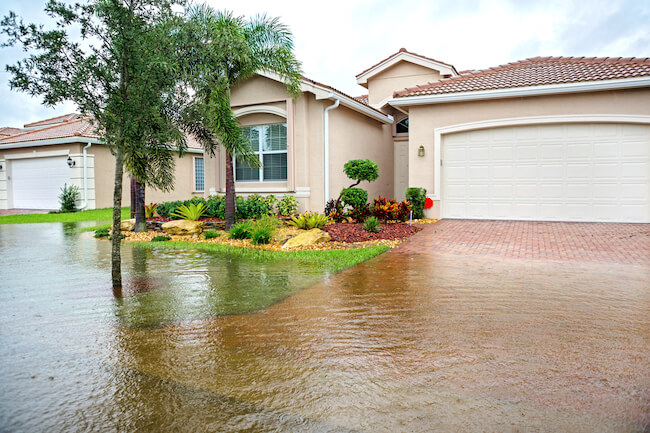According to the recent data from the Federal Emergency Management Agency, almost 90% of natural disasters that happen on the territory of the United States involve flooding. From this point, getting flood insurance might seem like a reasonable move. Moreover, homeowner policies normally don`t cover water damage.
But what if you live in an area where serious destructive floods have not happened for a long time and seem pretty unlikely to happen in the observable future? Is flood insurance that relevant for you in this case?
In this article, we shall talk about 5 essential things everyone should know about water damage and flood insurance, so you could make an informed decision and protect your property.

What are the real risks of damage from a flood?
To understand what is the potential of flood damage for your property, it is essential to determine what do emergency services and insurance companies consider a flood.
According to FEMA, flood events include:
- Inland flood
- Flash flood
- Flood from a heavy rainfall
That is why theoretically, there is a risk to become a victim of flood whether you are located next to a big water body, coastal area, or inland.
Once you move into a new location or relocate your business, you must research its flood potential and consider getting flood insurance.
You can get all the relevant information from the National Flood Insurance Program (NFIP)
What is the difference between flood insurance and a homeowners policy?
There are several things you should know before considering flood insurance as this type of insurance is different from most known policies:
- Flood insurance is an object of federal regulation. For instance, you can purchase this type of insurance from an agency certified by FEMA;
- In case you live in a flood-prone area, your local officials must have adopted a relevant flood management plan. It means that you can easily purchase federal flood insurance;
- Your homeowners' or renters' policies WILL NOT cover flood events.
What does flood insurance cover?
Coverage is the fundamental information you should learn and understand when you consider getting any policy. Here are the things that will get covered by flood insurance in case of disaster:
- The flood insurance coverage is very vivid. It covers the initial physical losses from the flooding event and the effect of the flood on your property. This may be property's erosion caused by the water, waves, currents as well as disasters that naturally accompany floods, aka storms, tide surge, and other similar scenarios;
- The standard flood insurance normally does not initially cover water damage to your vehicle. It is an optional add-on for standard car insurance;
- Your flood insurance will cover the house itself and its contents separately. It happens because the insurance provides for the repair costs of the building, but when it comes to the properties damage, the policy foresees the actual cash value of each item;
- The maximum flood insurance for the building itself is $250,000, and for its contents - $100,000;
- Once you are a business owner who wants to protect the assets from water damage, you should get commercial flood insurance. This policy provides for $500,000 coverage of the building structure and $500,000 for its contents.

How can I buy flood insurance?
Once you are seriously considering flood insurance, you should consider the following:
- You should address an insurance provider that has a contract with FEMA and offers NFIP policies. By now, there are more than 100 insurance companies in the United States to choose from;
- Keep in mind that your flood insurance will take action only 30 calendar days after the purchase. It means that if you decided to get one because you just got a flood warning from the authorities, most probably, you won`t manage to benefit from your fresh policy once the disaster strikes earlier.

Is flood insurance expensive?
Several factors would determine the cost of flood insurance for your property. An average American household pays about $500 for flood insurance every year. However, in your case, the numbers may vary dues to:
- Flood risk - the cost of your policy will be lower the lower is the flooding risk in the area;
- Home age and vulnerability to water damage;
- Type of policy depending on the flood risk;
- Coverage limit;
- The insurance company - though regulated by federal authorities, the flood insurance market remains free. It means that private companies can offer prices according to their judgment. However, due to the rising popularity of flood insurances in the United States, the market became particularly competitive. It means that you can get several quotes from various companies and always find the most appropriate one for you;
- Type of coverage. As we have already mentioned, flood insurance can cover the building itself and its contents. Once you are sure that water won`t get into the house or business itself but can cause certain damage to the building structure, you can save a great deal of money and get only the structure flood coverage.
Once you have an efficient and relevant flood protection method, you can save a lot of money on your flood insurance and energy and time after the disaster when you will have to collect your payments.
Flood barriers appear the most efficient modern way to keep floodwater off your property, selling all passages and giving you peace of mind that even a 3-foot flood won`t cause any damage to you or your property inside the house.
Contact Dam Easy today and learn about our innovative flood barriers and other methods to prevent water from getting into your house. While flood insurance will take care of the worst-case scenario, the innovative flood barrier will do its best to prevent it from happening.
Flood Barrier Door Dam - Ultimate Flood Gate

$949.00
DAM EASY® FLOOD GATE - DOOR DAM Floods are becoming more common around the world. What was once a 100-year phenomenon is now a seasonal trend that homeowners must deal with. That’s EXACTLY why you need this Dam Easy Flood… Read More



